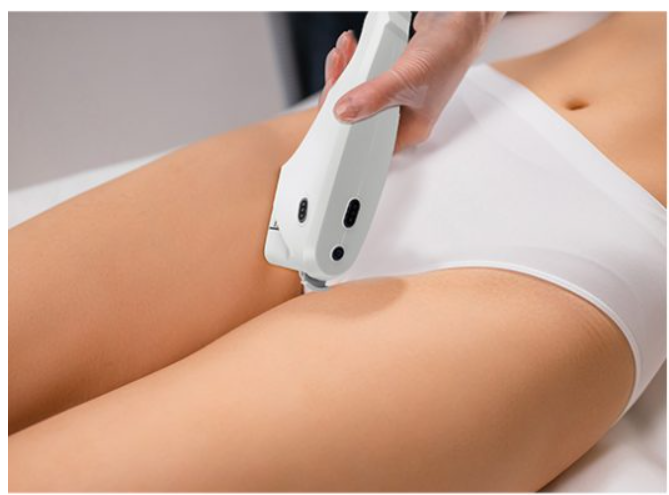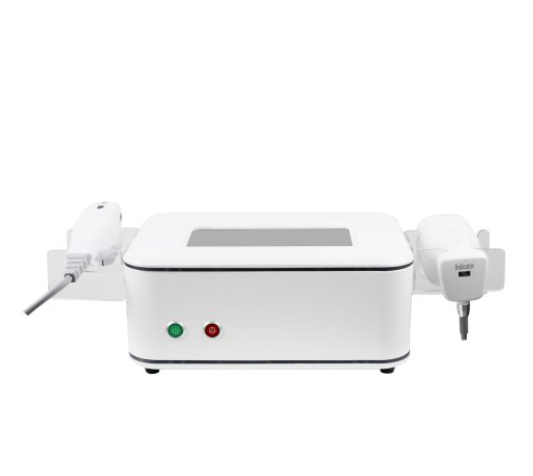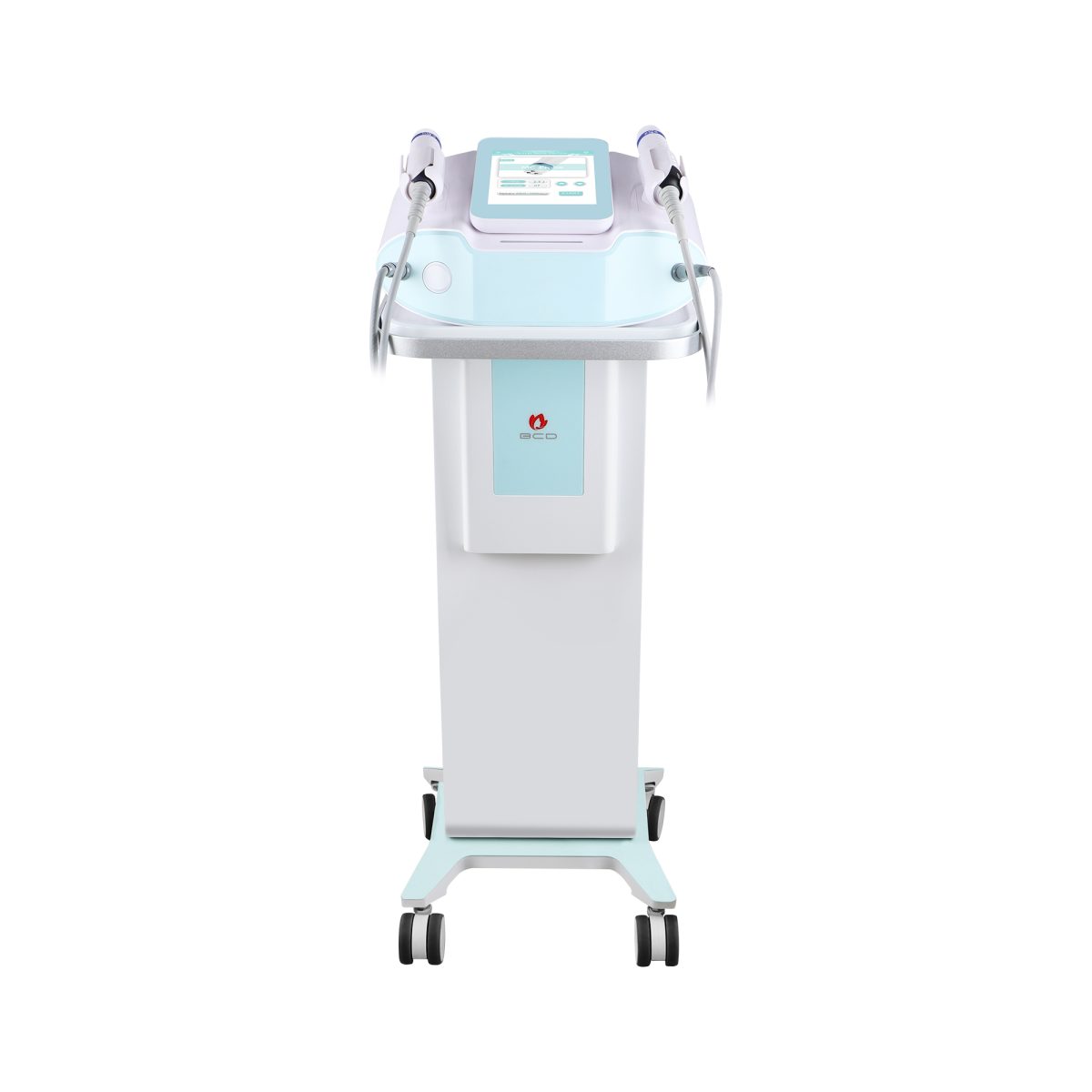In the medical field, HIFU machines are primarily used for non-invasive or minimally invasive treatments. One of the most well-known applications of HIFU is in the treatment of prostate cancer. HIFU can precisely target and destroy cancerous tissue in the prostate without the need for surgery or radiation.
In the cosmetic industry, HIFU machines are used for non-surgical facelifts and skin tightening procedures. The focused ultrasound waves penetrate deep into the skin, causing thermal coagulation points in the targeted areas. This thermal injury stimulates the production of collagen, leading to tighter and firmer skin.
HIFU machines are also utilized for body contouring and fat reduction treatments. The ultrasound energy can target and destroy fat cells in specific areas of the body, resulting in a slimmer appearance.

HIfu Manufacturing Process
The manufacturing process of HIFU machines involves several steps to assemble and produce the devices. Here is a general outline of the HIFU manufacturing process:
Design and Engineering: The process begins with the design and engineering phase, where experts develop the specifications, features, and functionality of the HIFU machine. This includes determining the ultrasound technology, power levels, treatment modes, control systems, and ergonomic design.
Sourcing of Components: Once the design is finalized, the manufacturer procures the necessary components and materials from trusted suppliers. These components may include ultrasound transducers, control panels, cooling systems, power supplies, circuit boards, cables, and other hardware elements.
Assembly: The assembly stage involves combining the sourced components to build the HIFU machine. Skilled technicians or automated assembly systems carefully integrate the various parts following specific instructions and guidelines provided by the engineering team. This includes mounting the transducers, connecting circuitry, integrating control panels, and incorporating cooling systems.
Quality Control and Testing: Quality control measures are implemented at various stages of the manufacturing process. Technicians or quality control personnel inspect the assembled HIFU machines to ensure they meet the required standards and specifications. Testing procedures are carried out to verify the functionality, performance, and safety of the devices. This includes conducting ultrasound tests, checking power output, verifying control panel functions, and performing diagnostic tests.
Calibration and Fine-Tuning: HIFU machines require precise calibration to ensure accurate ultrasound energy delivery and control. This step involves calibrating the transducers, power levels, treatment modes, and control settings to ensure optimal performance. Fine-tuning may be conducted to address any minor adjustments or optimizations needed for the device.
Packaging and Labeling: Once the HIFU machines pass all quality control tests and calibration procedures, they are prepared for packaging. The devices are carefully placed in suitable packaging materials, and labels with relevant product information, serial numbers, regulatory markings, and safety instructions are applied.
Documentation and Compliance: Proper documentation is prepared, including user manuals, technical specifications, and compliance documentation. This ensures that the HIFU machines comply with regulatory requirements and can be legally marketed and sold.
Distribution and Delivery: The packaged HIFU machines are then distributed to the designated destinations, whether they are healthcare facilities, cosmetic clinics, or other authorized distributors. Logistics and supply chain management play a crucial role in ensuring timely and efficient delivery.


HIFU Equipment and TechnologY
HIFU equipment incorporates advanced technology to deliver focused ultrasound energy for various medical and cosmetic applications. Here are some key components and technologies commonly found in HIFU equipment:
Ultrasound Transducers: Ultrasound transducers are the core components of HIFU machines. These transducers generate and focus high-intensity ultrasound waves into a precise focal point within the targeted tissue. The transducers can vary in frequency and size, depending on the intended application.
Focusing Mechanisms: HIFU machines utilize various mechanisms to achieve precise focusing of ultrasound energy. One common approach is the use of curved or concave transducer surfaces, which enable the ultrasound waves to converge at the desired focal point. Other technologies, such as phased array systems, may also be employed to electronically steer and focus the ultrasound energy.
Imaging Systems: Imaging systems are often integrated into HIFU machines to provide real-time visualization of the treatment area. Common imaging modalities include ultrasound imaging, MRI (Magnetic Resonance Imaging), or CT (Computed Tomography). These imaging technologies help guide the HIFU treatment, allowing physicians to accurately target the desired tissue and monitor the procedure in real-time.
Control Systems: HIFU machines feature sophisticated control systems that allow precise adjustment of ultrasound parameters, such as energy intensity, treatment duration, and focal depth. These control systems ensure accurate delivery of ultrasound energy while offering flexibility to customize treatment settings based on patient needs.
Cooling Mechanisms: To prevent damage to surrounding tissues and ensure patient comfort, HIFU machines incorporate cooling mechanisms. These mechanisms can involve water-based cooling systems, circulating coolants, or air cooling to maintain optimal temperature control during the procedure.
Safety Features: HIFU equipment includes safety features to protect patients and operators. These features may include real-time monitoring of temperature changes, automatic shutdown mechanisms in case of malfunctions, and built-in safety protocols to prevent excessive energy delivery.
User Interface: HIFU machines are equipped with user-friendly interfaces that allow operators to control and monitor the treatment process. The interface typically includes touchscreens or control panels where operators can adjust treatment parameters, visualize imaging data, and monitor treatment progress.
Energy Measurement and Monitoring: HIFU machines incorporate energy measurement and monitoring systems to ensure accurate and controlled energy delivery. These systems can include sensors or detectors that measure the intensity of the ultrasound energy, providing feedback to maintain consistent and reliable treatment outcomes.
Software and Algorithms: HIFU machines may utilize software and algorithms to optimize treatment planning, image processing, and treatment guidance. These software systems can assist in treatment customization, image registration, and treatment simulation.
Integration with Other Technologies: Depending on the specific application, HIFU machines may be integrated with other technologies. For example, in cancer treatment, HIFU may be combined with imaging modalities like MRI or PET (Positron Emission Tomography) for improved treatment planning and monitoring.
These are some of the key equipment and technologies used in HIFU machines. Manufacturers continuously innovate and improve these technologies to enhance treatment precision, patient outcomes, and overall user experience.
Quality Assurance:
Quality assurance is a crucial aspect of HIFU machine manufacturing to ensure that the devices meet the necessary standards, safety requirements, and performance expectations. Here are some key aspects of quality assurance in HIFU manufacturing:
Regulatory Compliance: HIFU machine manufacturers must comply with relevant regulatory guidelines and standards specific to their target markets. This includes obtaining necessary certifications and approvals to demonstrate that the devices meet the required safety and performance criteria. Common regulatory bodies involved in medical device approval include the FDA (Food and Drug Administration) in the United States, CE (Conformité Européene) marking in the European Union, and other national or regional regulatory authorities.
Design Verification and Validation: Before the manufacturing process begins, HIFU machine designs undergo thorough verification and validation processes. This involves testing the design against predetermined specifications and requirements to ensure that it functions as intended and meets the desired performance standards. Verification focuses on checking individual components, while validation assesses the overall system’s performance and safety.
Supplier Quality Management: HIFU machine manufacturers work closely with their suppliers to ensure the quality and reliability of the components and materials used in the manufacturing process. This involves conducting audits, inspections, and performance evaluations of suppliers to assess their capabilities and adherence to quality standards. Close collaboration with trusted suppliers helps maintain consistent quality throughout the manufacturing process.
Manufacturing Process Control: Manufacturers implement stringent process control measures to maintain the consistency and reliability of HIFU machine production. This includes standardized work instructions, operating procedures, and quality control checkpoints at various stages of assembly and testing. Process validation and control ensure that each device is manufactured consistently and according to the defined specifications.
Quality Control Testing: HIFU machines undergo rigorous testing procedures to verify their functionality, performance, and safety. This can include electrical safety tests, ultrasound power output measurements, temperature monitoring, imaging system calibration, and adherence to specific performance criteria. Random sampling or 100% inspection may be employed to ensure that each device meets the required standards.
Documentation and Traceability: Accurate and comprehensive documentation is crucial in quality assurance. Manufacturers maintain detailed records throughout the manufacturing process, including component sourcing, assembly procedures, quality control test results, and compliance documentation. Proper documentation facilitates traceability, enabling manufacturers to track each device’s history, components used, and any potential issues or recalls.
Post-Market Surveillance: Quality assurance extends beyond the manufacturing stage to post-market surveillance. Manufacturers actively monitor the performance and safety of their HIFU machines in real-world clinical settings. This involves gathering feedback from users, conducting post-market studies, and promptly addressing any reported issues or concerns.
Continuous Improvement: HIFU machine manufacturers engage in continuous improvement practices to enhance their products and manufacturing processes. This includes analyzing customer feedback, monitoring field performance data, and implementing corrective actions or design updates to address any identified issues or areas for improvement.
By implementing robust quality assurance measures, HIFU machine manufacturers can ensure that their devices meet the required standards, deliver consistent performance, and provide safe and effective treatments for patients.

Hifu Training and Support:
Training and support play a vital role in ensuring the safe and effective use of HIFU machines. Here are some key aspects of training and support provided by HIFU machine manufacturers:
Operator Training: HIFU machine manufacturers offer comprehensive training programs to educate healthcare professionals and operators on the proper operation of the devices. Training sessions cover topics such as device setup, calibration, treatment planning, treatment delivery techniques, and safety protocols. The goal is to ensure that operators have the necessary knowledge and skills to perform HIFU treatments accurately and safely.
Technical Training: Manufacturers provide technical training to service engineers and technicians who are responsible for the maintenance, troubleshooting, and repair of HIFU machines. This training equips them with the expertise to handle routine maintenance tasks, diagnose technical issues, and perform repairs or component replacements as needed.
User Manuals and Documentation: HIFU machine manufacturers provide comprehensive user manuals and documentation that detail the device’s operation, safety guidelines, troubleshooting procedures, and maintenance instructions. These resources serve as valuable references for operators and technicians, offering step-by-step guidance on various aspects of HIFU machine use and maintenance.
Customer Support: Manufacturers typically offer customer support services to address any questions, concerns, or technical issues that users may encounter. This can involve a dedicated support hotline, email support, or online chat services where users can directly communicate with technical experts. Prompt and responsive customer support ensures that users receive timely assistance and resolutions to their queries or problems.
Software Updates and Upgrades: HIFU machine manufacturers may provide software updates and upgrades to enhance device performance, add new features, or address any identified issues. These updates are typically communicated to users and may be accompanied by instructions on how to install and utilize the new software version effectively.
Continuing Education and Workshops: Manufacturers may organize workshops, seminars, or educational events to promote continuing education and knowledge sharing among HIFU machine users. These events offer opportunities for operators and healthcare professionals to stay updated on the latest advancements, best practices, and emerging techniques related to HIFU treatments.
Maintenance and Service Contracts: Manufacturers often offer maintenance and service contracts that provide scheduled maintenance visits, routine inspections, and preventive maintenance services for HIFU machines. These contracts help ensure that the devices are regularly checked, calibrated, and maintained by qualified technicians, maximizing their performance and longevity.
Online Resources and Training Materials: HIFU machine manufacturers may provide online resources, such as video tutorials, instructional videos, webinars, or e-learning platforms. These resources allow users to access training materials conveniently, review specific procedures, or refresh their knowledge on HIFU machine operation and maintenance.
By offering comprehensive training and support, HIFU machine manufacturers enable healthcare professionals and operators to utilize the devices effectively, maintain optimal performance, and ensure patient safety during HIFU treatments.
Market Trends and Future Outlook
Market trends and the future outlook for HIFU (High-Intensity Focused Ultrasound) machines indicate continued growth and development in various applications. Here are some key market trends and future prospects for HIFU machines:
Increased Demand in Aesthetic and Cosmetic Treatments: HIFU machines have gained popularity in the aesthetic and cosmetic industry for non-invasive skin tightening and rejuvenation procedures. The demand for non-surgical facelifts and body contouring treatments is expected to continue growing as people seek effective and minimally invasive alternatives to traditional cosmetic surgeries.
Advancements in HIFU Technology: Manufacturers are continuously improving HIFU technology to enhance treatment precision, efficacy, and patient comfort. This includes advancements in transducer design, imaging integration, treatment planning software, and cooling mechanisms. These technological advancements are expected to result in more targeted treatments, shorter procedure times, and improved patient outcomes.
Expanding Clinical Applications: HIFU is being explored for an expanding range of clinical applications beyond cosmetic treatments. In the medical field, HIFU is increasingly being used for targeted cancer therapies, including prostate cancer, uterine fibroids, liver tumors, and bone metastases. Ongoing research and clinical trials are investigating the potential of HIFU in areas such as neurological disorders, pain management, and drug delivery.
Combination Therapies: HIFU treatments are often combined with other modalities to enhance treatment outcomes. For example, combining HIFU with imaging technologies like MRI or PET allows precise targeting and real-time monitoring of treatments. Combination therapies that combine HIFU with other energy-based treatments or pharmaceutical agents are also being explored for synergistic effects and improved clinical outcomes.
Growing Adoption in Emerging Markets: HIFU machines are increasingly being adopted in emerging markets, driven by factors such as rising healthcare infrastructure, increasing disposable income, and growing awareness about non-invasive treatment options. As access to HIFU technology improves in these markets, the demand for both medical and cosmetic applications is expected to rise.
Shift towards Portable and Handheld Devices: There is a growing trend towards developing portable and handheld HIFU devices. These devices offer greater mobility and flexibility, allowing treatments to be performed in various clinical or non-clinical settings. Portable HIFU machines are particularly advantageous for delivering treatments in remote areas or during mobile healthcare campaigns.
Focus on Safety and Standardization: As the adoption of HIFU technology increases, there is an increasing focus on safety standards, regulatory compliance, and treatment protocols. Manufacturers and regulatory authorities continue to work towards establishing clear guidelines and standards to ensure the safe and effective use of HIFU machines across different applications.
Integration of Artificial Intelligence (AI): AI technology is being integrated into HIFU machines to improve treatment planning, image analysis, and automated control systems. AI algorithms can assist in treatment customization, optimize treatment parameters based on patient-specific factors, and enhance real-time monitoring and feedback during procedures.
Overall, the market trends for HIFU machines indicate a growing demand for non-invasive and targeted treatment options in both medical and cosmetic fields. With ongoing advancements in technology, expanding clinical applications, and increased accessibility, HIFU machines are poised to play a significant role in the future of healthcare and aesthetic treatments.

